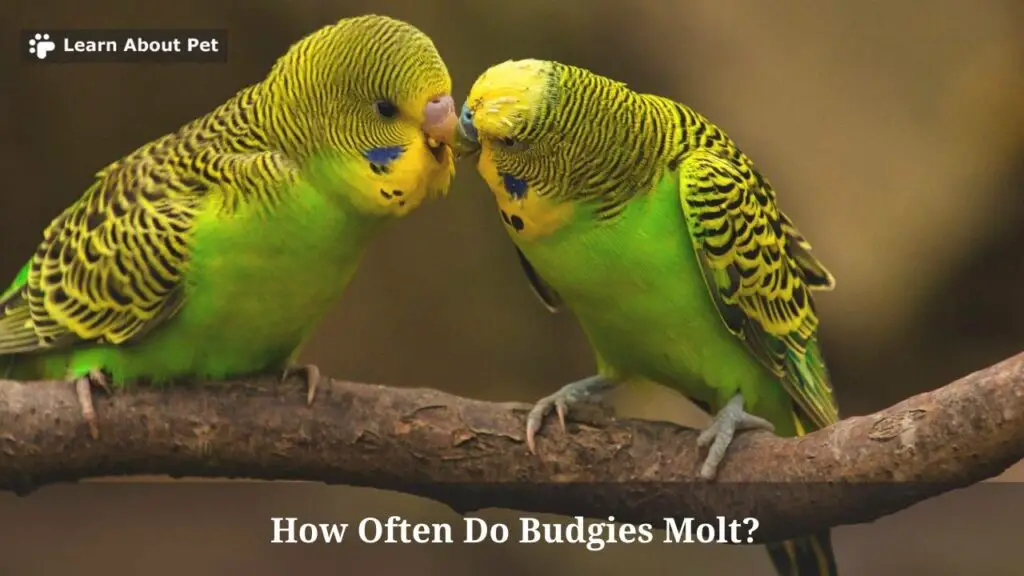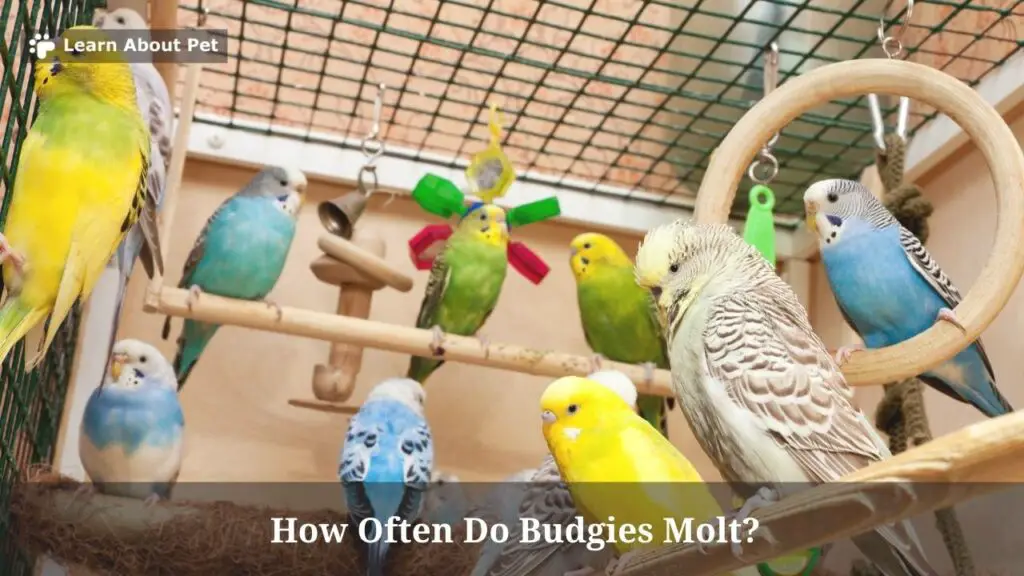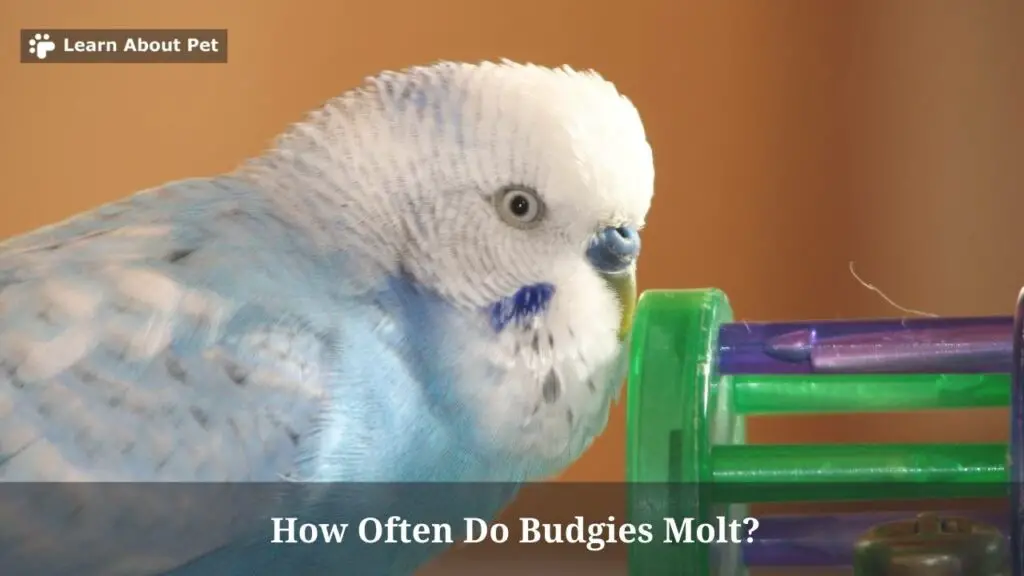One question that tends to come up in all budgie forums is on how often the budgerigars molt. In this article, you will find information on, among other things, how often budgies molt, how long they molt for and how you can help a molting budgie.
How often do budgies molt? Most budgies molt annually: that is, once per year. But there are some budgies that are able to molt twice or even thrice in a year.
Thus budgie molting frequency varies. You tend to find varying budgie molting patterns in different individuals.
And at times, it can be hard to figure out whether a budgie is going through the molting process or is sick. Indeed, that budgie molting or sick distinction can be rather hard to make.

This is because the classic budgie miserable molting signs can be mistaken for an illness, and vice versa.
And it is worth pointing out that there are conditions that can cause the molting process to stop… Those include stress and malnutrition.
Thus in understanding the parakeet molting behavior (budgie molting behavior), there are so many variables.
Then again, because budgies are rather small birds, there are people who have concerns on whether they are able to molt at all.
It therefore makes sense to start this discussion by addressing that question: on whether budgies molt at all.
Do Budgies Molt?
Yes, budgies do molt.
The molting process is one in which the budgies’ old feathers come off the body, the replacement being new feathers.
Thus a budgie that is going through the molting process gradually loses its old feathers. In the place of those old feathers, new ones grow.
If you talk to people who have kept budgies for any reasonable period of time, they will report having observed the molting phenomenon. This shows that budgies do molt.
And if you visit the forums in which budgie owners share ideas, you will find lots of threads on budgie molting. This too shows that budgies molt.
Further still, if you yourself keep budgies, there are times when you may find their old feathers falling off. Then you find new ‘pin feathers’ growing to take the place of those old ones that fall off.
That too goes to show that budgies do indeed molt.
Why Do Budgies Molt?
The budgie molting process entails old feathers falling off, and new ones taking their place.
One reason why budgies molt is in order to maintain feather health. If budgies didn’t molt, their feathers would eventually become old and unhealthy. Molting helps maintain budgie feather health.
It helps in renewal of the feathers.
Another reason why budgies molt is in order to maintain a good appearance. After molting, a budgie gets brand new feathers, which make it look very attractive. This can have implications, when it comes to reproduction.
Budgies that go through the molting process successfully look healthier and more attractive. It therefore becomes much easier for them to get mates with whom to reproduce.
How Often Do Budgies Molt?
Budgies typically molt annually: that is, once in a year. A few budgies however molt more frequently: like twice or thrice per year.
So it is reasonable to expect a budgie to molt at least once in a year. But if a budgie molts more than once in a year – like twice or thrice – that is normal too.
However, if apparent ‘molting’ happens more than thrice in a year, it may not be normal. It may be an illness…
The molting phenomenon starts quite early in a budgie’s life. This is around when the budgies are 3 months old. During the first molt, the budgie loses its baby feathers, with new ‘proper’ ones taking their place.
Then once the budgies have had those new feathers for another 3 or 4 months, they have their second molt. So this is roughly at the age of 6 or 7 months.
After that, if the budgies are destined for the usual annual molts, they will be molting on a yearly basis. Otherwise they may molt twice or thrice each year.
How Often Do Budgies Molt In The Wild?
So far, we have been making reference to budgie molting in captivity. That is with regard to pet budgies. But what about wild budgies? How often do budgies molt in the wild?
The answer is that there doesn’t seem to be much difference in budgie molting – in the wild or in captivity.
Thus budgies that are in the wild, just like those in captivity, normally molt once per year. But there are also some wild budgies – just like some pet budgies – that molt twice or thrice in a year.
When Do Budgies Molt Their Feathers?
In answering the question on how often budgies molt, we also have to deal with the aspect of when it happens.
When do budgies molt their feathers? The answer is that budgies can molt their feathers at any time of the year. Molting in budgies is not based on seasons.
It can happen at any point in the year. There are even cases in which budgies molt during the winter, causing themselves considerable discomfort.
The key thing to understand is that the budgies usually molt annually, with some molting twice or thrice yearly. But there is no specific point in the year when the molting happens.
The best you may be able to do is start taking note of when your individual budgie usually molts. With time, you may notice patterns on the basis of which you can try predicting when the next molt is likely to be.
How Long Does A Budgie Molt For?
Alongside the question on how often budgies molt normally comes this one: on how long the budgies molt for.
So, indeed, how long does a budgie molt for? Like with regard to the first molt, how long does a budgie first molt last? What about the subsequent ones? How long do they last?
The answer is that the budgie molting process is not abrupt. It is a gradual process: which typically goes on for two or three weeks.
The gradual nature of the budgie molting process serves an important purpose. If a budgie were to lose all its feathers at once, it would be left with no insulation on its body.
Therefore such a body would have to endure a lot of cold. The feathers keep the budgie warm. This is why the budgie can’t afford to lose all its feathers at once.
Moreover, the feathers are helpful when it comes to flying. Were a budgie to lose all its feathers at once, it would lose the ability to fly. So this is another reason why the budgie’s molting process is gradual.
The budgie molting process typically takes 2 to 3 weeks. This applies with regard to the budgie’s first molt, and all subsequent ones.
How Many Times A Year Do Budgies Molt?
In exploring the subject of budgie molting frequency, there is one more angle we need to look at. This is the angle of exactly how many times in a year budgies molt.
As it turns out, most budgies only molt once per year. Therefore if you have a budgie that molts on an annual basis, that is entirely normal.
However, there are some budgies that are able to molt more than once per year. So a budgie may molt twice or even thrice in a year. Again this is normal.
It may, however, not be normal for a budgie to molt more than thrice in a year.
All in all, there is no single answer to the question on how many times a year budgies molt. Some molt once a year. Others molt twice per year. And others still molt thrice per year.
Most, however, seem to be of the annual molting tendency. Those that molt twice or thrice a year are outliers.

What Determines How Often Budgies Molt?
So far, we have been saying that most budgies molt once per year – but a few are able to molt twice or thrice.
This leads to a question on what determines how often budgies molt.
The main determinant of how budgies molt is their genetic heritage. There are some budgies whose genetic makeup is such that they need to molt twice or thrice per year.
Then there are those whose genetic makeup is such that they can only molt once per year.
Of course, the environmental conditions in which a budgie finds itself may have some impact here.
Even the budgie’s diet may affect how often it molts. For instance, a budgie that is severely malnourished may almost stop molting altogether.
Another potentially impactful factor is stress levels. A budgie that is experiencing too intense stress may almost stop molting altogether.
What Does A Molting Budgie Look Like?
Normally, a molting budgie will have pin feathers, whose color is normally white, and they look like stubs.
Note that a molting budgie doesn’t have entirely bald spots on its body. If you find such entirely bald spots, they would be a sign of illness.
But it does have spots on which stub-like feathers (the pin feathers) are present.
There are other budgie molting symptoms: such as a tendency to sleep more and eat more. Thus if you were wondering, do budgies sleep more when molting, the answer is ‘yes’.
The mood of a budgie that is molting may also tend to become somewhat nasty.
It is important to appreciate that the molting process is not an easy one for the budgie. It is a process in which the budgie’s body has to work hard to produce new feathers.
It is also a time when the budgie tends to feel vulnerable.
How Do You Help A Molting Budgie?
With regard to the aspect of how to help a molting budgie, there are several things you can do.
First of all, you need to start by figuring out what to feed a molting budgie. And this needs to be a balanced diet, with plenty of protein and vitamins.
There are special food products that are formulated for molting budgies. You can buy one such product for your budgie.
Another helpful thing is to provide a dark space for the budgie to rest during this hard period. You may also try to minimize disturbances, considering that a molting budgie normally needs as many as 10 to 12 hours of sleep.
So these are the helpful bits, when addressing a budgie’s first molt needs. They are also helpful in addressing all the subsequent molting needs.
Why Does My Budgie Keep Molting?
Sometimes, you may notice a pattern in which your budgie seems to keep on molting.
That then naturally gets you wondering, why is my budgie molting so much? Or precisely why does my budgie molt so much?
As we said, it is normal for a budgie to molt once, twice or thrice per year. If the budgie is molting more than thrice per year, it may not be true molting. It may be a disease – like, say, the viral disease we refer to as ‘French molt’.
So a budgie that molts too often (like more than thrice per year) may require veterinary attention.
Final Verdict – How Often Do Budgies Molt
Most budgies molt on an annual basis: which is to say that they molt once every year.
There are, however, some budgies that are able to molt twice or thrice per year.
The molting process helps the budgies to rid themselves of old feathers, and grow new ones as replacements.
In budgies, the molting process typically takes 2 to 3 weeks. And it can happen at any point in the year: there is no special season for it.
In a baby budgie, the first molt normally happens at around 3 months of age.

A budgie that is molting is always in a stressful and vulnerable situation. You need to provide it adequate rest, avoid unnecessary handling and ensure it gets a balanced diet.
There are specially formulated commercial feeds for budgies that are molting. These may be helpful in certain situations.
If a budgie molts more than thrice per year, this may not be normal. Similarly, if it has completely bald spots on its body during the molting process, that may not be normal.
Those may be signs of an illness such as French molt. Therefore budgies experiencing such molting-related issues may require veterinary attention.
As a pet lover, make sure to learn about pet more and give your pet parakeet a good and comfortable life!

Welcome to Learn About Pet. My name is Rajkumar Ravichandran and I love all pets, travel, and amazing food. I write about my passion and personal experience caring for multiple pets in this blog! ❤️
Post Disclaimer
DISCLAIMER: THIS BLOG OR WEBSITE, "Learn About Pet", DOES NOT PROVIDE YOU WITH MEDICAL ADVICE AND IS NOT A SUBSTITUTE FOR MEDICAL ADVICE. ALWAYS GET IN TOUCH WITH YOUR PERSONAL VETERINARIAN AND USE INFORMATION HERE AS GENERAL ADVICE.
The information, including but not limited to, text, graphics, images and other material contained on this website are for informational purposes only. No material on this site is intended to be a substitute for professional veterinary advice, food recommendation, diagnosis, or treatment. Always seek the advice of your veterinarian or other qualified health care provider with any questions you may have regarding a medical condition or for pet food related questions.







